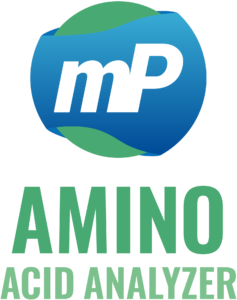Aminosäuren wie Glutaminsäure, Prolin und Arginin sowie bioaktive Peptide spielen eine zentrale Rolle in kosmetischen Formulierungen zur Hautpflege, Feuchtigkeitsversorgung und Anti-Aging-Wirkung. Der ARACUS Aminosäureanalysator ermöglicht die präzise Analyse dieser Wirkstoffe, um ihre Konzentration und Wirksamkeit in kosmetischen Produkten zu kontrollieren. Die exakte Bestimmung unterstützt die Entwicklung funktioneller Kosmetika mit nachgewiesener Wirksamkeit auf Hautregeneration, Elastizität und Schutzmechanismen.
Aminosäuren und Peptide in Kosmetika, analysiert mit Aminosäureanalysator ARACUS
Zu den Aminosäuren des L-Typs, die in Kosmetika verwendet werden, gehören hauptsächlich L-Glutaminsäure, L-Prolin, L-Arginin und L-Serin. In der menschlichen Epidermis ist Glutaminsäure in großen Mengen vorhanden. Glutaminsäure kann in 2-Pyrrolidon-5-Carbonsäure (PCA) umgewandelt werden, die eine ausgezeichnete feuchtigkeitsspendende Wirkung hat. Sie ist ein wichtiger Bestandteil des natürlichen Feuchtigkeitsfaktors der Haut und der natürlichen Hautmetaboliten, der sicher und effizient ist.
Tatsächlich haben Studien gezeigt, dass PCA wesentlich zur Hydratation der Haut beiträgt, indem sie Wassermoleküle in das Stratum corneum zieht, die Hautelastizität verbessert und den transepidermalen Wasserverlust (TEWL) verringert (Rawlings & Harding, 2004).
Kollagen
Der Gehalt an Kollagen in der Dermis macht 25 bis 33 % des gesamten Proteins des menschlichen Körpers aus. Es unterstützt die Haut und ist auch ein wichtiges Material für die Reparatur von Gewebeschäden. Seine Hauptbestandteile sind L-Prolin und L-Hydroxyprolinsäure, L-Glycin, etc. L-Arginin ist die einzige Vorstufe für die Synthese von Stickstoffmonoxid, und es ist auch die Voraussetzung für die Synthese von Polyaminen, Prolin, Glutamat, Kreatin, Agmatin und Harnstoff. Es spielt eine wichtige Rolle bei der Zellproliferation, dem Energiestoffwechsel und den Endothelfunktionen. Es spielt dabei eine Schlüsselrolle und gilt als Reparaturkomponente, die EGF ersetzen kann.
Darüber hinaus hat sich gezeigt, dass L-Arginin die Kollagensynthese in dermalen Fibroblasten anregt, was es zu einem wertvollen Inhaltsstoff in Hautreparatur- und Anti-Aging-Formulierungen macht (Li et al., 2007).
Obwohl es sich bei L-Serin um eine nicht essenzielle Aminosäure handelt, ist sie für den menschlichen Stoffwechsel und die Immunprozesse unverzichtbar, insbesondere für die Synthese von Zellmembranen, Muskeln und Nervenhüllen.
L-Serin trägt auch zur Differenzierung der Epidermis und zur Barrierefunktion bei, da es ein Schlüsselfaktor für die Keratinozytenproliferation ist (Metallo et al., 2013).
Peptide in Kosmetik
Signalpeptide können den Proteinkanal an der Zellmembran öffnen, damit das synthetisierte Protein eine bestimmte Wirkung erzielt. Sie können auch als Wachstumsfaktoren wirken, die Proteinkinase C aktivieren und Zellwachstum und -migration beeinflussen. Carrier-Peptid ist ein spezifisches Dipeptid (Gly-L-His-L-Lys, GHK), das für den Transport und die Stabilisierung von Spurenelementen wie Kupfer und Mangan verantwortlich ist. Es kann spontan Komplexe bilden und diese in die Haut transportieren, damit sie von den Zellen aufgenommen werden. So kann beispielsweise eine Creme, die den Tripeptid-Kupfer-Komplex GHK-Cu enthält, die Elastizität und Festigkeit der Haut verbessern und feine Linien und tiefe Falten reduzieren.
Die Fähigkeit von GHK-Cu, Wundheilungsprozesse zu aktivieren, die Aktivität antioxidativer Enzyme zu steigern und die Produktion von Kollagen und Glykosaminoglykanen anzuregen, wurde umfassend untersucht (Pickart et al., 2008).
Die Rolle der inhibitorischen Peptide der Neurotransmitter
Neurotransmitter-hemmende Peptide können über Hautmediatoren mit dem Nervensystem interagieren und diese Mediatoren aktivieren oder hemmen. Einige Peptide stützen sich auf strukturelle Ähnlichkeit, um ihre Struktur durch kompetitive Bindung zu destabilisieren und die Freisetzung von Acetylcholin aus den Nervenenden zu verhindern, wodurch die Wirkung dieses Neurotransmitters reguliert wird. Solche Peptide werden in Anti-Aging-Kosmetika verwendet und hemmen nachweislich die Ausschüttung von Neurotransmittern, weshalb sie auch als Neurotransmitter-Inhibitorpeptide bezeichnet werden. Catenin und Isocenin beispielsweise sind zwei ikonische Aminosäuren, die das Elastin bewahren und in der Kosmetik und anderen Bereichen weit verbreitet sind.
Peptide wie Acetylhexapeptid-8 (Argireline) haben einen ähnlichen Wirkmechanismus gezeigt und reduzieren nachweislich die Faltentiefe, indem sie die Freisetzung von Neurotransmittern und die Muskelkontraktion modulieren (Blanes-Mira et al., 2002; Wang et al., 2019).

Hinweis: Die zu diesem Artikel gehörige PDF ist zum Download nur auf Englisch verfügbar.
Quellen:
Rawlings AV, Harding CR. Moisturization and skin barrier function. Dermatol Ther. 2004;17 Suppl 1:43-48.
Li P, et al. L-arginine enhances collagen synthesis and cell proliferation in fibroblasts. Int J Mol Med. 2007;20(3):387-392.
Metallo CM, et al. Serine and glycine metabolism in cancer. Trends Biochem Sci. 2013;38(3):152-161.
Pickart L, et al. The human tripeptide GHK and tissue remodeling. J Biomater Sci Polym Ed. 2008;19(8):969-988.
Blanes-Mira C, et al. A synthetic hexapeptide (Argireline) with anti-wrinkle activity. Int J Cosmet Sci. 2002;24(5):303-310.
Wang X, et al. Acetyl hexapeptide-8 and botulinum toxin: similarities and differences. J Cosmet Dermatol. 2019;18(4):1144-1150.

